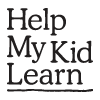Ages and Stages
Children learn differently and reach the important stages of learning in different ways and at different times. In each age group we talk about some of the learning stages to look out for and how you can help your baby and your children to learn. We give possible ages when children reach certain stages of learning but often these ages don’t quite fit and the stages happen at other ages – earlier or later. So it’s important not to feel there is a problem if your friend’s child is doing things differently than your child.
By about 3 years old
Children’s language develops a lot between the ages of 2 and 3. By the time they are 3 years old you will usually be able to understand most of what they say to you, though other people may find it harder.
Children now know and use lots of words. They often make sentences using 4 or 5 words together. They are starting to use some small grammar words (I, a, the) and you might hear sentences like ‘I go see Susie’, ‘Me can’t find teddy’, ‘Where you going?’
They add ‘s’ more often now (shoes, cats) and they might try out ‘ed’ endings like ‘We walked’. If they use this in the wrong place, such as, ‘We wented,’ you can help by saying the right word when you reply: ‘Yes, we went to the shop.’ They may still mix up some sounds.
Many children are starting to draw squiggles or lines using crayons, chalk or finger paint.
3 year-old children ask lots of questions, using the words ‘What?’ ‘Where?’ They can remember and talk about things in the past.
They like to listen to stories and to look at the pictures in the book – perhaps they will get a book and look at it themselves. They usually hold a book the right way up and turn the pages. They will answer or ask questions about the story or the pictures. They can tell you a story about something that has happened or make up a story.
They understand instructions such as, ‘Let’s put your shoes on’ or ‘Bring me your pyjamas.’
By the time they are 3, many children like to organise and put similar objects together. They might like to pick out the red blocks or to put all the spoons in a line. Some children try to count the blocks or spoons.
They are starting to try to understand the world and other people. Their use of language reflects this growing awareness. They begin to express their own feelings and to see what other people are feeling: ‘Is that boy sad?’’ I don’t like that.’ ‘Are you cross?’
Children of this age often like pretend play – they might pretend to pour a cup of tea and give it to you. They might like to dress up as different characters. Sometimes they pretend to be an animal or a made-up creature. This is all part of their developing imagination and understanding the world around them and is important for their understanding when they start to read and write.
By about 4 years
Children can often speak fairly clearly by this age, though many still find some sounds difficult. Groups of sounds can be hard - they might say ‘bider’ for ‘spider’. They can make longer sentences and link ideas or events using linking words: and, but, so. They ask and answer ‘Why?’ questions.
They often like longer stories and can answer a few questions about the pictures and about what’s happening in the story. If they like to make up their own stories they often want to tell them to you.
They can follow longer instructions such as, ‘Please put your toy in the box and get your pyjamas.’ They can listen carefully. They answer questions about things that have happened during the day.
At this age many children are beginning to look at and name different shapes – circle, square. Some children are starting to recognise letters, especially the start of their own name. They recognise and talk about different colours (red socks; blue sky). They can count small numbers and might look out for 3 red apples or 5 bananas for you in the shop.
They like to use a wider range of drawing equipment. Some still prefer crayons and chalk, others like pencils. They like to scribble and some children are starting to make more exact drawings which they can tell you about (‘This is a cat.’ ‘That’s daddy eating.’)
They might like to help with tasks that help them to learn, such as sorting and folding washing or putting out the knives and forks for dinner. Again children vary a lot – some will do this, others won’t. They are starting to count more. They might like to count the forks on the table, how many chairs there are, how many socks are in the washing.
